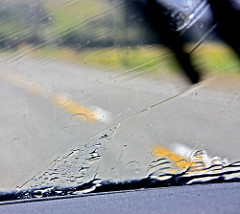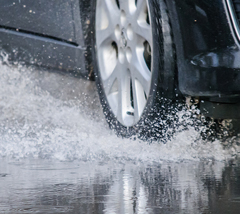Spring weather in the UK is known for being unpredictable and prone to heavy rain. Driving in these conditions can be dangerous if the proper precautions are not taken. Take a look at our wet weather driving and maintenance tips to ensure that you stay safe on the road.

Driving in wet weather can be potentially dangerous due to the decreased visibility caused by rain and spray from the road. Fully functional windscreen wipers will ensure that, regardless of the amount of rain and road spray, good visibilty will be maintained while driving. Aged windcreen wipers however, or ones with cracks or splits, will not clear your windscreen properly, like in this image.
If your windscreen does not fully clear and is left with smudged water marks after each pass of your windscreen wiper, you should consider having then replaced. This is a quick and inexpensive job, but one that will make a big difference.

During rain, roads develop puddles of standing water deep enough to cause aquaplaning. This occurs when the tyres tread depth is insufficient to cut through and remove the water quick enough, causing water to build up in front of the tyre until the volume of water lifts the tyre from the road, causing total loss of control.
To avoid this check that your tyres have adequate levels of tread depth to maintain contact with the road in wet conditions.
Plan Ahead
Before setting off you should check the weather and be prepared by filling up your fuel tank and by carrying a spare mobile phone or an in-car charger. If heavy rain is forecast you should allow extra time for your journey and avoid routes which may be prone to flooding.
Slow Down
Reduce your speed when driving in wet conditions as it allows for better reaction times, which is useful when your visibility is reduced, which can help to reduce your risk of skidding or aquaplaning. This is because when you drive at slower speeds, more of your tyre will be in constant contact with the surface of the road, enhancing traction and stability.
Keep Your Distance
Braking distances can be doubled in wet conditions, so your driving should reflect this. Keep a gap between yourself and the car in front, double what it would usually be as this will allow you to slow down and stop safely.
Make No Sudden Movements
When you do brake, you should do so slowly, which is another reason why it is beneficial for you to keep a larger gap from the vehicle in front. Sudden braking in wet conditions can cause your wheels to lockup, which can cause you to skid. If you do find yourself skidding, release the foot brake and turn into the skid. This will allow your wheel to turn again, allowing you to regain control.
Avoid Deep Standing Water
Flooded areas are a potentially hazardous condition for drivers and could do extensive damage to your vehicle. If you cannot avoid driving through a flooded area, you must first gauge the depth of the water and avoid it if it is deeper than six inches standing or four inches moving.
Before driving through a flooded area, make sure that you have a clear path through, so that you will not have to stop, and drive slowly on the highest part of the road.
If you have any concerns that your vehicle or tyres may not be up to the task of driving in wet conditions, visit your local Dexel Tyre & Auto Centre for further advice and information.